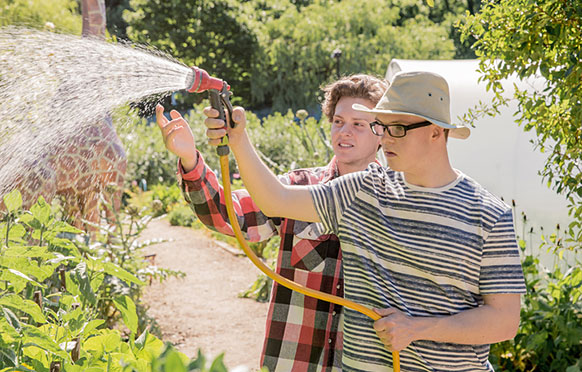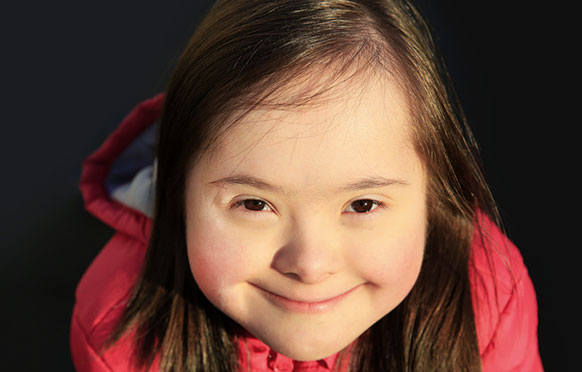
Fact Sheet FS1288
Introduction
When planning and delivering programs for clientele with developmental disabilities it is important for educators to understand the legal protections and to learn how to make the appropriate accommodations and modifications needed for successful participation.
The Americans with Disabilities Act (ADA)
The Americans with Disability Act (ADA) defines disability as a mental or physical impairment that substantially limits one or more major life activities. A major life activity is one that is central to daily life. These activities include walking, seeing, hearing, breathing, caring for oneself, sitting, standing, lifting, learning, thinking, working, and performing manual tasks. The activities that would be most applicable to educational programs are those that affect communication, learning, self-care, self-direction, social skills, and performing manual tasks. ADA protection extends not only to individuals who currently have a disability, but to those who have a record of a mental or physical impairment that substantially limits one or more major life activities, or who are perceived or regarded as having a mental or physical impairment that substantially limits one or more major activities.
The Americans with Disabilities Act (ADA) of 1990; the ADA Amendments Act of 2008 (P.L. 110-325) which became effective on January 1, 2009; and the New Jersey Law Against Discrimination (NJLAD) prohibit discrimination on the basis of disability. The term disability is broadly defined under these laws and includes but is not limited to:
- Learning, psychological or developmental disabilities
- Physical impairments, illnesses, malformations, or disfigurements
- Visual or hearing impairments, speech impediments, AIDS, HIV infection, sickle cell trait, and other atypical hereditary cellular blood traits
The ADA gives civil rights protections to individuals with disabilities like those provided to individuals on the basis of race, color, sex, national origin, age, and religion. It guarantees equal opportunity in public accommodations, employment, transportation, state and local government services, and telecommunications. The ADA enables society to benefit from the skills and talents of individuals with disabilities.
The Rehabilitation Act of 1973 and the Individuals with Disabilities Education Act (IDEA)
There are two additional laws that are relevant or specific to school settings: The Rehabilitation Act of 1973 (29 U.S.C. 794d) and the Individuals with Disabilities Education Act (IDEA).
Like the ADA, the Rehabilitation Act prohibits discrimination based on disability in programs run by federal agencies and that receive federal financial assistance, including institutions of higher learning. Section 504 of the Rehabilitation Act ensures that a child with a disability has equal access to an education. The child may receive accommodations and modifications. For example, program accessibility and effective communication with people who have hearing or vision disabilities. Each federal agency has its own set of Section 504 regulations that apply to its programs. The U.S. Department of Education ensures students with disabilities receive the educational services needed for success in school. Unlike the Individuals with Disabilities Education Act (IDEA), Section 504 does not require a public school to provide an individualized educational program (IEP) which is designed to meet a child's unique needs and provide the child with educational benefit. Under Section 504, fewer procedural safeguards are available to children with a disability and their parents/guardians than under IDEA.
Section 508 of the federal Rehabilitation Act requires agencies to provide individuals with disabilities equal access to electronic information and data comparable to those who do not have disabilities, unless an undue burden (e.g., significant difficulty or expense) would be imposed on the agency. Public universities that receive federal funding through the Assistive Technology Act are required to meet Section 508 standards for web-based intranet and internet information and applications. Examples of materials that would require accommodations would include:
- Videos that have audio must have captioning and text transcripts
- Audio files must have text transcripts
- Images must have alternate text or descriptions set for them to convey meaning
- Color-blind individuals must be able to interpret a page successfully
- HTML tables must use the appropriate tags to designate column headers
The U.S. Department of Agriculture is committed to making its electronic and information technologies accessible to individuals with disabilities by meeting or exceeding the requirements of Section 508 of the Rehabilitation Act, as amended in 1998.
Inclusion
Inclusion means to involve individuals with disabilities in the same clubs, events, activities, and programs as individuals without disabilities. It is vital that all participants, those with and without disabilities, are provided with the same opportunity to learn and develop skills. Inclusion results in a rewarding experience for all involved, including greater self-reliance and self-confidence for those with disabilities. Participants without disabilities can experience a greater awareness of the strengths and challenges experienced by others. There are opportunities for individuals to learn from other life experiences, recognize the unique skills in group members, develop an awareness of barriers that prevent full participation, and strategies to remove those barriers.
Program Accommodations and Modifications
The term "accommodation" may be used to describe an alteration of environment, curriculum format, or use of equipment that allows an individual with a disability to gain access to content and/or complete assigned tasks. Program accommodations allow students with disabilities to participate fully in educational venues or activities. Accommodations alter the educational experience's method, but not the content being taught. Examples of accommodations include:
- sign language interpreters for individuals who are deaf
- computer text-to-speech systems for individuals with visual impairments or dyslexia
- extended time for individuals with fine motor limitations, visual impairments, or learning disabilities
- large-print books and worksheets for individuals with visual impairments
- trackballs and alternative keyboards for individuals who cannot operate a standard mouse and keyboard
The term "modification" may be used to describe a change in the curriculum or educational content. Modifications are made for individuals with disabilities who are unable to comprehend all of the content an instructor is teaching. For example, tasks or activities might be reduced in number and/or modified significantly for an individual with cognitive impairments that limit their ability to understand the content.
When there are individuals with disabilities participating in a program, it is important to modify and adapt program requirements, the activity, and/or the physical environment to meet the needs of individuals taking part. The Office of Disability Services or similar office can provide assistance with accommodations. Other sources are included in the Information on Academic Accommodations section.
Below are two types of program accommodations:
- Provide equipment that accommodates the individual's physical needs. For example, a person in a wheelchair could participate in a gardening project using a raised garden bed or container gardening.
- Adapt the physical environment if necessary. Accommodations might include adapted heights of seating or tables, color-coding kitchen utensils, or adapting equipment or lighting.
Below are two types of program modifications:
- Modify the project or activity to match the ability of the individual. For example, the method of giving instruction or the number of steps required to complete the task may be altered based on the individual's abilities.
- Modify program requirements if necessary. In an animal project, for example, a person with disabilities may be able to receive assistance from another individual to take care of and/or show an animal.
Information and Communication
Communication with family members, caregivers, and the individual is important to better serve and involve both youth and adult participants with disabilities in the programs. It must be assumed that the participant can do any task or program until they express that they cannot or need a modification/accommodation. The accommodations provided must be approved by the participant and/or legally consenting guardians.
It is best to determine the needs of participants as early as possible to plan for any agreed-upon accommodations. A protocol for legally, respectfully, and efficiently ascertaining whether there are individuals with disabilities with such needs in a program should be developed such as an optional information sheet or optional section of the program registration form. This form should be provided to all participants as it would be considered discrimination to require only certain participants to complete the information based on assumptions made. The questions posed should focus on the accommodations and assistance that individual participants need to be successful in the program and should not be used as a vehicle for labeling the specific disability that affects the participants.
At all times, maintain confidentiality of all personal information while following the organization’s policies and procedures and. Ensure that the medical history portion of the program enrollment paperwork is complete and accurate. Keep it readily available, but confidential.
Below are some tips regarding communication and information gathering:
- Using the suggested protocol, obtain information about the individual including any mobility; healthcare or behavioral management needs; their communication style and abilities (hearing, vision, speech); and the need for assistance with daily tasks such as eating or using the bathroom.
- If needed, inquire about the participant's developmental reading level and listening ability to prepare program material that is accessible and appropriate.
- Involve youth and parents/guardians or the adult and their caregiver as much as possible in setting goals and modifying the program to meet the individual's needs.
- Obtain suggestions from the parent/guardians or caregiver about strategies to best engage the youth or adult participant. Be aware that sometimes problematic or inappropriate behavior is often the default behavior for individuals with developmental disabilities. Discuss with the child's parents or the adult's caregiver the probability of inappropriate behavior and how to best defuse or address these behaviors. Youth participants may have a Behavior Intervention Plan or Individualized Education Plan at school. Community-based educators do not have access to these plans; however, parents/guardians may elect to share such plans to better meet the participant's needs.
- Identify special dietary needs and chewing or swallowing problems. If a special diet is necessary, the parent or caregiver should provide food. When food or cooking is involved, be sure to gather information about any food allergies or intolerances; sensory issues such as food texture or temperature; oral-motor skills; or significant mealtime behaviors. Be especially vigilant regarding hygiene and safety when cooking.
Evaluation and Research
When utilizing end-of-program evaluations or conducting other types of programmatic survey research, be sure to review the requirements and procedures of the organization, school, or university (Institutional Review Board). It is important to identify the individual's ability (cognitive and physical) to complete evaluations or surveys; provide appropriate accommodations; and determine the individual's ability to consent or who can consent on their behalf.
Open to All - Equal Opportunity Program Provider
As a public educational entity, Cooperative Extension is an equal opportunity program provider and employer. Cooperative Extension must comply with the Americans with Disabilities Act (ADA) which states that no qualified individual with a disability shall, by reason of such disability, be excluded from participation in or be denied the benefits of services, programs, or activities of a public entity, or be subjected to discrimination by any such entity. The ADA and state law(s) prohibit discrimination based on disability. Rutgers University adheres to the ADA and the New Jersey Law Against Discrimination (NJLAD) and provides reasonable accommodation to qualified individuals with disabilities unless it imposes undue hardship.
If accommodations are needed, contact the State Extension Director's Office; local or state Department of Human Services; or the Affirmative Action Officer in to assist in appropriately serving program participants.
Summary
A disability is a mental or physical impairment that substantially limits one or more major life activities. Inclusion means to involve individuals with special needs in the same clubs, events, and programs as individuals without special needs.
The Americans with Disabilities Act (ADA) enables society to benefit from the skills and talents of individuals with disabilities and guarantees equal opportunity. Obtain information about participants' abilities and maintain confidentiality. Educators must comply with all federal and state regulations and should acquaint themselves with how to secure the services provided through their Office of Disability Services or similar office. It may be necessary to modify the project or activity, program requirements or physical environment to accommodate the clientele's needs.
Information on Academic Accommodations
- Disabilities, Opportunities, Internetworking, and Technology. (2001). Building the team: faculty, staff, and students working together. University of Washington. Retrieved April 20, 2024. Video available at www.washington.edu/doit/videos/index.php?vid=3.
- Disabilities, Opportunities, Internetworking, and Technology. (2015). What is the difference between accommodation and modification for a student with a disability? University of Washington. Retrieved April 20, 2024, from www.washington.edu/doit/what-difference-between-accommodation-and-modification-student-disability.
- Disabilities, Opportunities, Internetworking, and Technology. (2022). Working together: faculty and students with disabilities. University of Washington. Retrieved April 20, 2024, from www.washington.edu/doit/working-together-faculty-and-students-disabilities.
- Disabilities, Opportunities, Internetworking, and Technology. (2012). Working together: K–12 teachers and students with disabilities. University of Washington. Retrieved April 20, 2024, from www.washington.edu/doit/working-together-k12-teachers-and-students-disabilities.
Additional Training
Training is available for individuals who provide programming and/or support to youth and adults with developmental disabilities. The Skillfully Working with People with Developmental Disabilities training series is available online through a partnership with Colorado State University.
References
- Council for Exceptional Children. (2017). Understanding the Differences between IDEA and Section 504. LD Online. Retrieved April 20, 2024, from www.ldonline.org/article/6086
- Division of Developmental Disabilities. (2020). Supports Program and Community Care Program Policies and Procedures: A Quick Guide for Families. The New Jersey Department of Human Services. Retrieved April 20, 2024 from https://www.nj.gov/humanservices/ddd/assets/documents/quick-guide-for-families-english.pdf
- Rutgers Cooperative Extension. (n.d.). Skillfully Working with People with Developmental Disabilities. Colorado State University. Retrieved April 22, 2024, from https://www.online.colostate.edu/badges/developmental-disabilities/
- Rutgers University Ethics and Compliance. (n.d.). Disability Compliance. Rutgers University Human Resources. Retrieved April 20, 2024 from https://radr.rutgers.edu/aboutODS
- Rutgers University Access and Disability Resources. (n.d.). About the Offices of Disability Services. Rutgers University Human Resources. Retrieved April 20, 2024 from https://radr.rutgers.edu/aboutODS
- State of New Jersey Department of Law and Public Safety. (2024). Division on Civil Rights. Office of the Attorney General. Retrieved April 20, 2024. https://www.njoag.gov/divisions/division-on-civil-rights-home/
- United States Code, 2018 Edition, Supplement 4, Title 42: The Public Health and Welfare; Chapter 126 Equal Opportunity for Individuals with Disabilities. (2022). Retrieved April 20, 2024 from https://www.govinfo.gov/app/details/USCODE-2022-title42/USCODE-2022-title42-chap126-subchapII/summary
- United States Department of Justice, Civil Rights Division. (n.d.) Communicating Effectively with People with Disabilities. ADA.gov. Retrieved April 20, 2024 from https://www.ada.gov/topics/effective-communication/
- United States Department of Justice, Civil Rights Division. (n.d.) Introduction to the Americans with Disabilities Act. ADA.gov. Retrieved April 20, 2024 fromhttps://www.ada.gov/topics/intro-to-ada/
- United States Department of Agriculture. (March 2024). Accessibility Statement. Retrieved April 20, 2024. https://www.usda.gov/accessibility-statement
- Wrights Law. (n.d.) Section 504 and ADA: Protecting Children with Disabilities from Discrimination. Retrieved April 20, 2024 from https://www.wrightslaw.com/info/sec504.index.htm
This publication is based on the work of Jeannette Rea Keywood, 4-H Agent and Michelle Brill, Family and Community Health Sciences Educator.
July 2024
Copyright © 2025 Rutgers, The State University of New Jersey. All rights reserved.
For more information: njaes.rutgers.edu.
Cooperating Agencies: Rutgers, The State University of New Jersey, U.S. Department of Agriculture, and Boards of County Commissioners. Rutgers Cooperative Extension, a unit of the Rutgers New Jersey Agricultural Experiment Station, is an equal opportunity program provider and employer.



